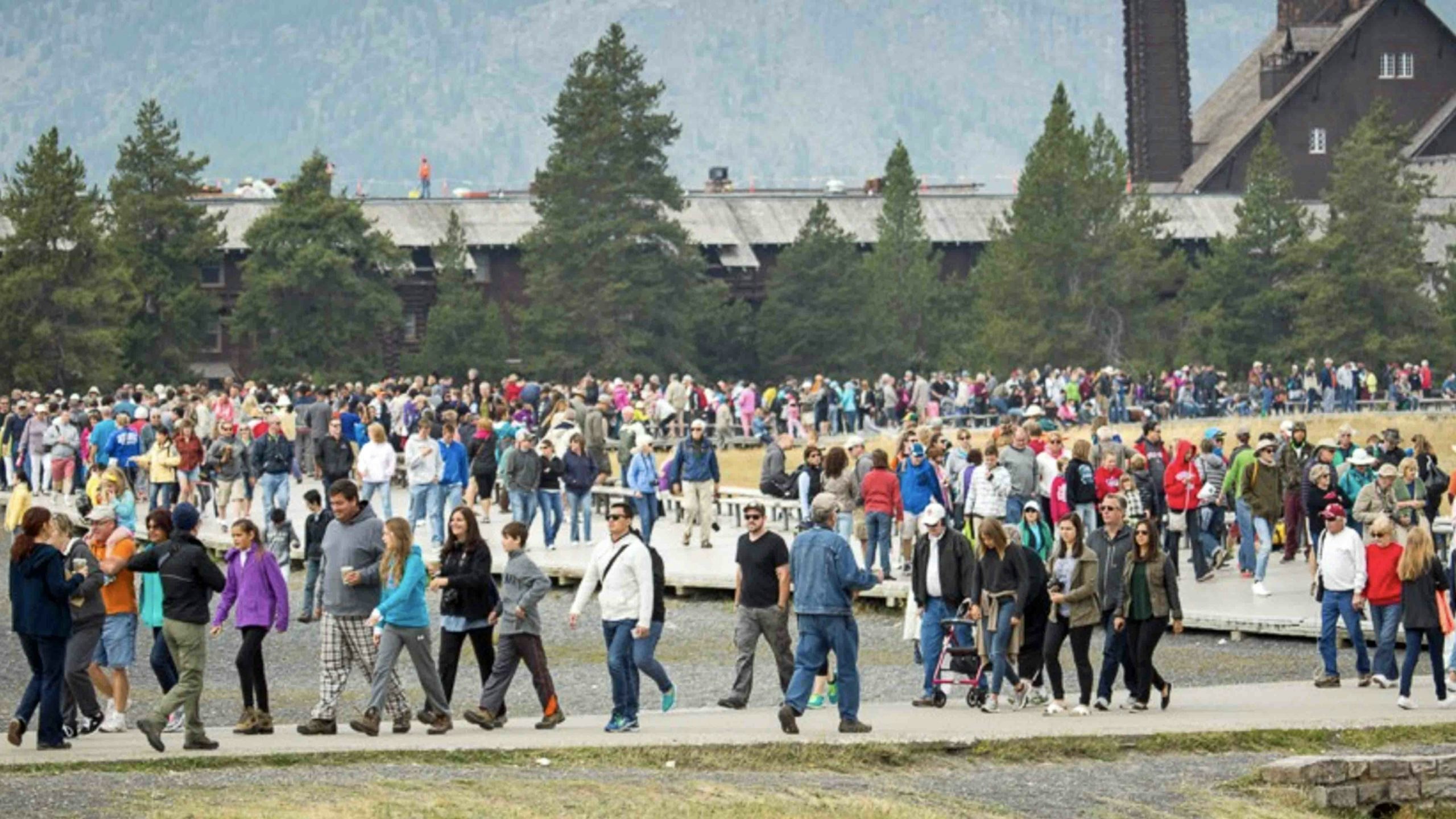Yellowstone National Park officially turns 150 years old next month and park officials are working hard to make sure future visitors continue to enjoy its natural wonders.
The way visitors experience the park has changed dramatically since it was established by Congress on March 1, 1872 — and park Supervisor Cam Sholly said he and his staff are working to deal with the growing number of visitors who access only a small part of the park.
“Keep in mind that Yellowstone is 2.2 million acres, it’s bigger than Delaware and Rhode Island put together,” Sholly said. “Approximately 1,750 acres of that are roads, and less than 6,500 acres are considered developed out of the 2.2 million acres.”
“We estimate that somewhere around 98% of visitors never get more than a half mile away from their car, so what that means is the majority of the visitation in Yellowstone is located in far less than 1% of the park,” he added.
And that 1% is getting crowded, especially compared to numbers collected almost a century ago.
In 1904, park officials recorded 13,727 visitors; 2021 data showed that 4,860,242 people entered the gates.
The region has always drawn visitors – the first were the Native American tribes who hunted, fished, gathered plants and used the thermal waters for medicinal and spiritual purposes over 10,000 years before the area was declared a national park.
European Americans began exploring the area in the early 1800s, with the first official expedition arriving in 1869.
“At the time of the passing of the Yellowstone Park Act, not a single member of Congress had actually been here on the ground or had seen this area with their own eyes,” Sholly said. “And so it’s, I think, even more remarkable that a landmark congressional action like this would have been taken largely based on paintings in reports from the (first) expedition.”
Visiting Yellowstone was no mean feat in the early years. According to the website yellowstonepark.com, even as late as 1882, only 1,000 people a year came to Yellowstone, traveling via saddle horses or mules, as trails to the region were not well maintained.
The National Park Service’s website noted that railroad lines were extended to the park in 1883, which is also when the U.S. Army Corps of Engineers began to build some roads into the area, allowing easier visitor access. That access brought a boost in visitation that first year to 5,000.
Col. William F. “Buffalo Bill” Cody led visitors to Yellowstone from the town he founded, using what is now U.S. Highway 14/16/20. Additionally, visitors could take the railroad to Cody, to Livingston, Montana, or West Yellowstone, Montana, and catch motor buses into the park. When automobiles were allowed into Yellowstone in 1915, visits became easier and more economical.
While the visitor experience is much more hands-off today, in the early 1900s, visitors could immerse themselves in some of the cooler hot springs; tours were given via horse and stagecoach. While today’s travelers enjoy paved highways and accommodations at modern facilities, early visitors rode in bumpy, dusty coaches and lodging was much more primitive.
As access grew, so did visitation. Visitation to the park exceeded more than 1 million for the first time in 1948 — now that number regularly surpasses 4 million per year. And the popularity of the destination keeps growing, which is causing some concern for Yellowstone Park managers – particularly when it comes to the park’s infrastructure.
“We will conduct a number of major groundbreakings for over $125 million in projects funded to the Great American Outdoors Act, thanks to our congressional partners and champions like U.S. Senator Steve Daines (R-Montana) and others, for helping us address critical infrastructure and deferred maintenance,” Sholly said. “These projects for the upcoming year include two of the largest historic preservation projects in the country, and then an assortment of transportation projects including bridge replacements, and road improvements.”
Some roads, such as the route over Dunraven Pass, have been closed in recent years for renovation.
“In 2022 we will reopen the road between Chittenden Road and Tower, over Dunraven Pass,” Sholly said. “This has been closed for the past two years, part of a $28 million road improvement project – and for context, this portion of road has not been substantially improved since the 1930s.”
Sholly noted that park staff have been collecting a robust amount of visitor use data over the last few years.
“We’re using that data to inform our decision making in a variety of key areas,” he said. “Moving forward, we’ve got a shuttle feasibility study underway to look at how a shuttle system could work in the Old Faithful-Midway Geyser corridor.”
Many of you know that we piloted the first driverless shuttle at Canyon this past summer to see if that technology can work; we think it can,” he continued. “And we’re working on quite a few micro-geographic visitor management actions that we think can be used in different locations through time to more effectively manage visitation. Obviously, as visitation goes up, those actions will need to be more aggressive.”
March 1 marks the 150th anniversary of the establishment of Yellowstone National Park. As part of the anniversary commemoration, Xanterra Parks and Resorts, the official concessionaire in Yellowstone, will be hosting a public event on May 6, coinciding with the summer season opening of the Old Faithful Inn.





